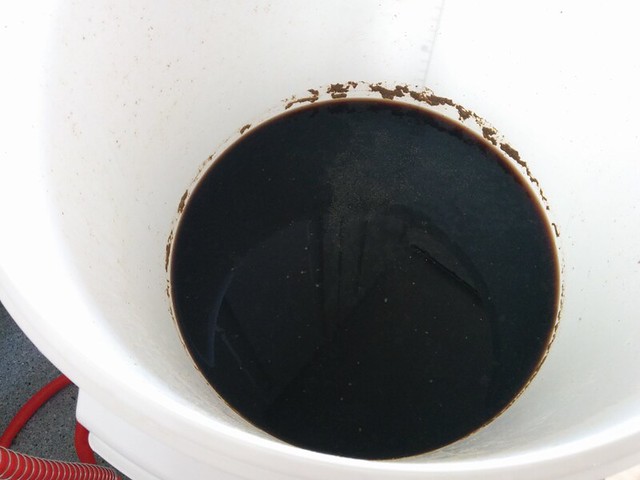I've made a couple AG brews with my co-workers before (pale ales), and now I've made my first brew on my own.
It's a Fuller's Black Cab Stout clone (all grain), and doesn't taste anything like the original.
Frankly I have never tasted a beer that was anything like this...
The recipe is taken from here with slight modifications, as I didn't have access to exactly the same malts.
Here's my recipe:
I split the batch into two fermetation vessels so that I could test two different yeasts with the same recipe.
Fermentation was very quick; the airlocks stopped bubbling after 24 hours (maybe because I used twice the amount of yeast that one would normally use?). I tried to keep the temperature at 65-70F using a water bath for the first couple of days. After that they we're at room temperature, which is around 73F.
It's now 14 days since brewing, and I've just bottled the beer. I know it's can take a long to time for porter/stout to mature, but on the other hand I've read here that if a beer is bad, it won't become a good beer with time?
Tastewise my first instinct was that the beer tastes sour, but I took a PH reading and it's not low (around 4.4). The smell of the beer is nothing like an English porter/stout; it's a bit unpleasant but maybe it's because when you look at it you expect it to smell of chocolate, coffee, etc. If someone smelled it blindfolded, they might think it's rosé wine! I guess it's just very fruity. If I pinch my nose while tasting it, then it tastes almost like normal porter. It also tastes very sweet. Maybe I'll just name this beer Banana Split?
So is my only mistake that I fermented at too high a temperature? Or is there something else I've missed? I don't think I have a contamination, most of my equipment is brand new and I sterilized them using alcohol.
By the way, after I made this beer, I used Bru'n Water to check my water. It estimates the mash PH for this brew to be 4.7!! Did that affect my beer? The water here in Finland is very soft/pure, so they actually add a little bit of gypsum to it to prevent corrosion, but apparently not enough for making a dark beer...
Here's a picture of the fermeted beer before bottling; there was very little krausen:

It's a Fuller's Black Cab Stout clone (all grain), and doesn't taste anything like the original.
Frankly I have never tasted a beer that was anything like this...
The recipe is taken from here with slight modifications, as I didn't have access to exactly the same malts.
Here's my recipe:
Code:
20 litres batch size, but ended up being only 18 (too little sparging).
3.80 kg Pale Ale (2-row) (6.0 EBC) 79.7 %
0.28 kg Caraamber (Weyermann) (70.9 EBC) 6.0 %
0.28 kg Chocolate Malt (886.5 EBC) 6.0 %
0.20 kg Oats, Flaked (2.0 EBC) 4.2 %
0.20 kg Roasted Barley (1000.0 EBC) 4.2 %
35.00 g Fuggle [4.50 %] - Boil 60.0 min 21.0 IBUs
19.00 g East Kent Goldings (EKG) [5.00 %] - Boil 30.0 min 9.7 IBUs
19.00 g East Kent Goldings (EKG) [5.00 %] - Boil 0.0 min 0.0 IBUs
BIAB Single Infusion at 69C (156F), Full Body, No Mash Out
Half batch with:
1.0 pkg SafAle English Ale (DCL/Fermentis #S-04)
And the other half with:
1.0 pkg Windsor Yeast (Lallemand)
Measured Original Gravity: 1.050 SG
Measured Final Gravity: 1.010 SG (Windsor) / 1.014 SG (SafAle)I split the batch into two fermetation vessels so that I could test two different yeasts with the same recipe.
Fermentation was very quick; the airlocks stopped bubbling after 24 hours (maybe because I used twice the amount of yeast that one would normally use?). I tried to keep the temperature at 65-70F using a water bath for the first couple of days. After that they we're at room temperature, which is around 73F.
It's now 14 days since brewing, and I've just bottled the beer. I know it's can take a long to time for porter/stout to mature, but on the other hand I've read here that if a beer is bad, it won't become a good beer with time?
Tastewise my first instinct was that the beer tastes sour, but I took a PH reading and it's not low (around 4.4). The smell of the beer is nothing like an English porter/stout; it's a bit unpleasant but maybe it's because when you look at it you expect it to smell of chocolate, coffee, etc. If someone smelled it blindfolded, they might think it's rosé wine! I guess it's just very fruity. If I pinch my nose while tasting it, then it tastes almost like normal porter. It also tastes very sweet. Maybe I'll just name this beer Banana Split?
So is my only mistake that I fermented at too high a temperature? Or is there something else I've missed? I don't think I have a contamination, most of my equipment is brand new and I sterilized them using alcohol.
By the way, after I made this beer, I used Bru'n Water to check my water. It estimates the mash PH for this brew to be 4.7!! Did that affect my beer? The water here in Finland is very soft/pure, so they actually add a little bit of gypsum to it to prevent corrosion, but apparently not enough for making a dark beer...
Here's a picture of the fermeted beer before bottling; there was very little krausen:




